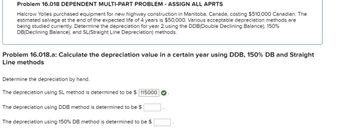
FINANCIAL ACCOUNTING
10th Edition
ISBN: 9781259964947
Author: Libby
Publisher: MCG
expand_more
expand_more
format_list_bulleted
Concept explainers
Topic Video
Question

Transcribed Image Text:Problem 16.018 DEPENDENT MULTI-PART PROBLEM - ASSIGN ALL APRTS
Halcrow Yolles purchased equipment for new highway construction in Manitoba, Canada, costing $510,000 Canadian. The
estimated salvage at the end of the expected life of 4 years is $50,000. Various acceptable depreciation methods are
being studied currently. Determine the depreciation for year 2 using the DDB(Double Declining Balance), 150%
DB(Declining Balance), and SL (Straight Line Depreciation) methods.
Problem 16.018.a: Calculate the depreciation value in a certain year using DDB, 150% DB and Straight
Line methods
Determine the depreciation by hand.
The depreciation using SL method is determined to be $ 115000
The depreciation using DDB method is determined to be $
The depreciation using 150% DB method is determined to be $
Expert Solution
This question has been solved!
Explore an expertly crafted, step-by-step solution for a thorough understanding of key concepts.
This is a popular solution
Step 1: Introducing Depreciation Expense
VIEW Step 2: Calculate the Annual Depreciation Expense Using Straight Line Method
VIEW Step 3: Calculate the Depreciation Expense for Year 2 Using Double Declining Balance Method
VIEW Step 4: Calculate the Depreciation Expense for Year 2 Using Declining Balance Method
VIEW Solution
VIEW Trending nowThis is a popular solution!
Step by stepSolved in 5 steps

Knowledge Booster
Learn more about
Need a deep-dive on the concept behind this application? Look no further. Learn more about this topic, accounting and related others by exploring similar questions and additional content below.Similar questions
- Problem 10 The Maria Lovella Mining Company purchased for P13,000,000 mining property estimated to contain 1,000,000 tons of ore. The residual value of the property is P1,000,000. Buildings used in mine operations costs P1,000,000 and have an estimated life of ten years with no residual value. Mine machinery costs P2,000,000 with an estimated residual value of P400,000 after its physical life of 4 years. Following is the summary of the company's operations for the first two years: Second Year First Year 100,000 tons Tons mined 130,000 tons Tons sold 80,000 tons 120,000 tons P 45.00 Unit selling price per ton Direct labor P 44.00 P 800,000 P 840,000 Miscellaneous mining overhead P 160,000 P 240,000 Operating expenses P 720,000 P 760,000 Inventories are valued on a first-in, first-out. Depreciation on the building is to be allocated as follows: 20% to operating expenses, 80% to production. Depreciation on machinery is chargeable to production. Question: 26. The cost of inventory (ore) in…arrow_forward5arrow_forwardNonearrow_forward
- i need the answer quicklyarrow_forwardMODULE 5 8-7 DISPOSAL OF ASSET Please read the problem below and provide the correct answer along with an explanation of the answer. Thank you! Dump It is selling a machine that no longer is large enough for the production requirements. Dump It has had the machien for 3 years and has depreicated it using the straightline method. Original cost had been $98,000 and salvage was estimated at $6000. The machine has a life of 8 years. a) Journalize the sale of the imagine $70,000 b) Journalize teh sale of the machine for $50,000arrow_forwardvvk.3 You are evaluating two different milling machines to replace your current aging machine. Machine A costs $236,244, has a three-year life, and has pretax operating costs of $67,855 per year. Machine B costs $417,560, has a five-year life, and has pretax operating costs of $32,660 per year. For both milling machines, use straight-line depreciation to zero over the project’s life and assume a salvage value of $35,626. Your tax rate is 34 % and your discount rate is 10 %. What is the EAC for Machine A?arrow_forward
- Exercise 13-17A (Algo) Asset replacement decisions-opportunity cost LO 13-5 Jordan Freight Company owns a truck that cost $42.000 Currently, the truck's book value is $22,000, and its expected remaining useful life is five years. Jordan has the opportunity to purchase for $30100 a replacement truck that is extremely fuel efficient. Fuel cost for the old truck is expected to be $5,600 per year more than fuel cost for the new truck. The old truck is paid for but, in spite of being in good condition, can be sold for only $10,000 Required Calculate the total relevant costs. Should Jordan replace the old truck with the new fuel-efficient model, or should it continue to use the old truck until it wears out? Total relevant costs Should Jordan replace or continue the old truck? Keep Old Replace the old truck Replace With Newarrow_forwardDomesticarrow_forwardPlease answer last three requirement, If possible answer all the parts please other answer last 3 partsarrow_forward
arrow_back_ios
SEE MORE QUESTIONS
arrow_forward_ios
Recommended textbooks for you

 AccountingAccountingISBN:9781337272094Author:WARREN, Carl S., Reeve, James M., Duchac, Jonathan E.Publisher:Cengage Learning,
AccountingAccountingISBN:9781337272094Author:WARREN, Carl S., Reeve, James M., Duchac, Jonathan E.Publisher:Cengage Learning, Accounting Information SystemsAccountingISBN:9781337619202Author:Hall, James A.Publisher:Cengage Learning,
Accounting Information SystemsAccountingISBN:9781337619202Author:Hall, James A.Publisher:Cengage Learning, Horngren's Cost Accounting: A Managerial Emphasis...AccountingISBN:9780134475585Author:Srikant M. Datar, Madhav V. RajanPublisher:PEARSON
Horngren's Cost Accounting: A Managerial Emphasis...AccountingISBN:9780134475585Author:Srikant M. Datar, Madhav V. RajanPublisher:PEARSON Intermediate AccountingAccountingISBN:9781259722660Author:J. David Spiceland, Mark W. Nelson, Wayne M ThomasPublisher:McGraw-Hill Education
Intermediate AccountingAccountingISBN:9781259722660Author:J. David Spiceland, Mark W. Nelson, Wayne M ThomasPublisher:McGraw-Hill Education Financial and Managerial AccountingAccountingISBN:9781259726705Author:John J Wild, Ken W. Shaw, Barbara Chiappetta Fundamental Accounting PrinciplesPublisher:McGraw-Hill Education
Financial and Managerial AccountingAccountingISBN:9781259726705Author:John J Wild, Ken W. Shaw, Barbara Chiappetta Fundamental Accounting PrinciplesPublisher:McGraw-Hill Education


Accounting
Accounting
ISBN:9781337272094
Author:WARREN, Carl S., Reeve, James M., Duchac, Jonathan E.
Publisher:Cengage Learning,

Accounting Information Systems
Accounting
ISBN:9781337619202
Author:Hall, James A.
Publisher:Cengage Learning,

Horngren's Cost Accounting: A Managerial Emphasis...
Accounting
ISBN:9780134475585
Author:Srikant M. Datar, Madhav V. Rajan
Publisher:PEARSON

Intermediate Accounting
Accounting
ISBN:9781259722660
Author:J. David Spiceland, Mark W. Nelson, Wayne M Thomas
Publisher:McGraw-Hill Education

Financial and Managerial Accounting
Accounting
ISBN:9781259726705
Author:John J Wild, Ken W. Shaw, Barbara Chiappetta Fundamental Accounting Principles
Publisher:McGraw-Hill Education